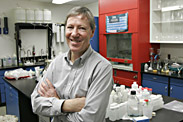Digging up the dirt
More than a century of industrial activity has left Canada with hundreds of acres of land contaminated with metal. Current approaches to cleaning up these sites cost millions of dollars, but they don't have to, according to William Hendershot, a professor in the Department of Natural Resource Sciences.

William Hendershot, professor in the Department of Natural Resource Sciences
Owen Egan
Hendershot is an expert on trace metals in soils. Metals occur naturally in soil in minute amounts, and life on Earth has evolved to cope with only small exposure to these elements. Many industrial processes concentrate metals like copper, cadmium, lead and zinc. These can then end up in the earth.
"When we concentrate these metals we create a potential problem, because metals in a high enough concentration do affect organisms," said Hendershot.
Dust, runoff and outdoor storage can all dramatically increase the amount of metal in soil. Hendershot explained that, for instance, the soil around hydrotowers tends to be high in zinc, a result of runoff from the galvanized steel in the structures.
"[Contamination is] an inevitable process of how people have been doing business in the past," he said.
The current method to clean up a site contaminated with metal is low-tech, to say the least. Usually the soil is simply trucked away and dumped at a disposal site. This solves nothing, according to Hendershot -- it simply moves the problem to a different location. It may also be unnecessary.
Hendershot's recent research looks at two separate aspects of soil contamination: determining the nature of the hazard and cleaning it up.
The latter is the result of research Hendershot conducted with Qing Ru Zeng, a visiting scholar from China. One of the current technologies for cleaning soil contaminated with metal is to "wash" it with a compound called ethylenediamine-tetraacetic acid (EDTA). This chemical works by bonding with metal, then the EDTA and metal can be rinsed out.
The problem is that EDTA is itself a contaminant, and is expensive to use. Hendershot and Zeng wanted to find out if there was a way to recycle EDTA so that it could be used multiple times, thus reducing remediation costs. They were able to do so by treating the EDTA with a sulfide.
"The sulfide is capable of out-competing the EDTA for the metals, which then precipitate as a sulfide; this is the same form that metals take in ores," explained Hendershot. With this process, both the EDTA and the metals recovered from the soil can be used once more.
Even with the reduced costs of this new technique, the technology is not likely to find widespread application, according to Hendershot.
"[Economically] You can't compete with not doing much of anything… But we wanted to demonstrate that this was a viable alternative to stockpiling the soils," he said.
"Soil decontamination is not economically viable because the government allows companies to just dig up contaminated soils and dump them in a special landfill site, and that's cheaper than doing anything else with them. As long as the policy is that just transferring soil from one place to another is acceptable, then the technology will never take off. We're also just stockpiling the problem for future generations: we're just taking soils from different sites in the city and dumping them in one site where they'll have to be dealt with eventually anyway."
A better way to deal with the problem is to focus our efforts. Hendershot believes government regulations that determine threat levels of contaminated sites are flawed.
"What the government regulates is the total metal in the soil, which doesn't have anything to do with how bioavailable the metal in the soil is," he said. Bioavailability means how much of a contaminant is actually going to end up being in exposed organisms. Metals like lead, for instance, though very toxic to humans, are unlikely to pose much of a threat in soil.
"Lead is only dangerous if children play on the site and eat the dirt. If you cover up the site with a metre of [clean] soil, and make sure there is no possibility of contaminated soil moving up the surface, then basically the danger from the lead is zero," he said.
"It does sometimes make sense to bury the problem. People tend to not like that idea, but if they see it as a choice of cleaning up a site that isn't doing any harm or putting money into health care, I think they would very quickly see that if you have a limited budget then the choice would be fairly obvious."
When a site can be controlled by such cheap and low-tech methods, it would allow regulators to use more expensive technologies like EDTA on sites that do pose a real threat, such as those sites contaminated by a more mobile metal like cadmium.
"We may be spending millions of dollars to clean up soils that actually aren't dangerous. The other side of the coin is that we might be able to allow some contaminated soils to stay in place as long as they're safe, and cleaning up those soils that are dangerous."
